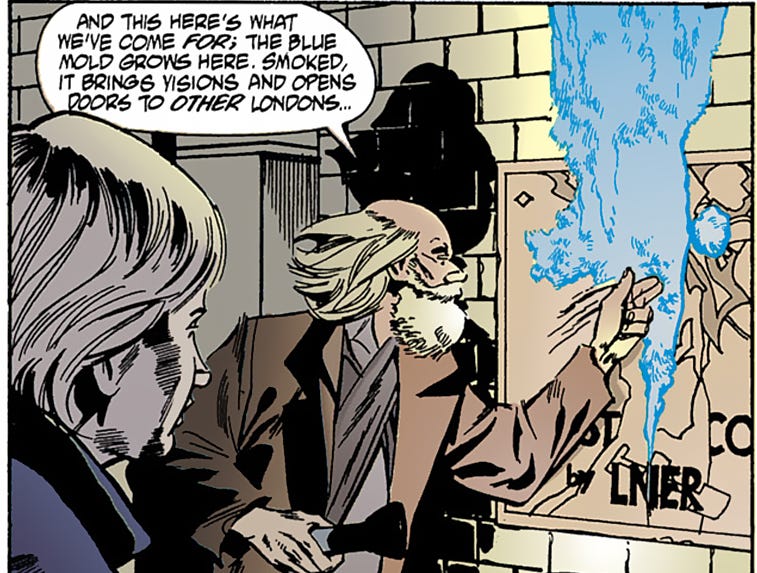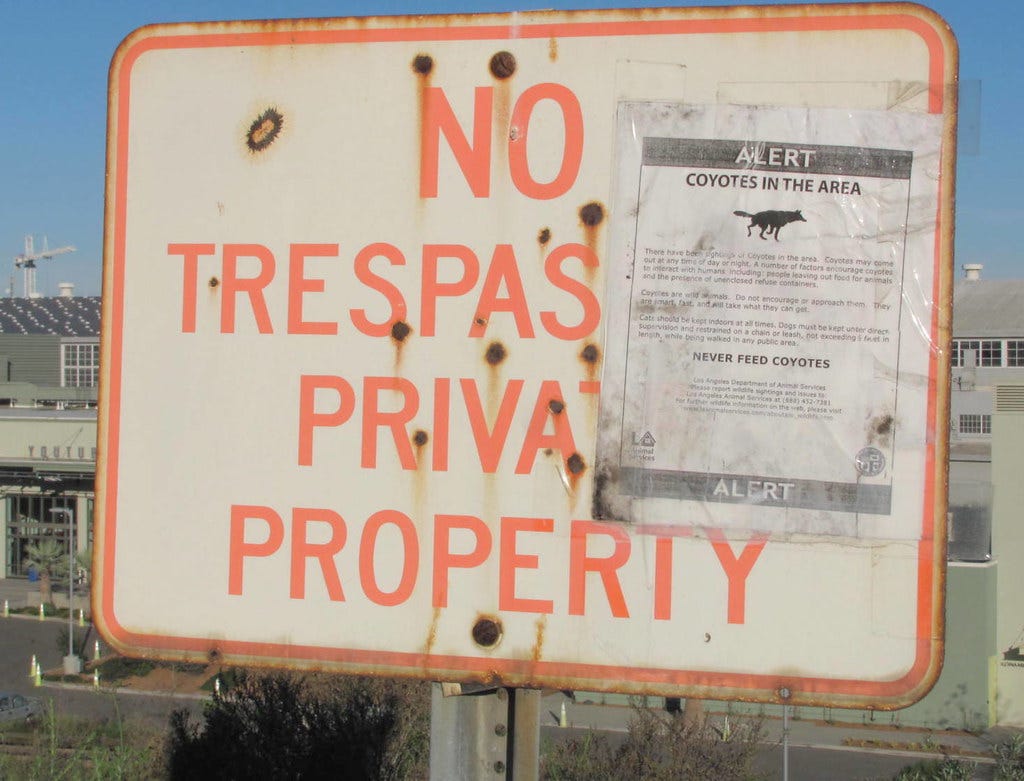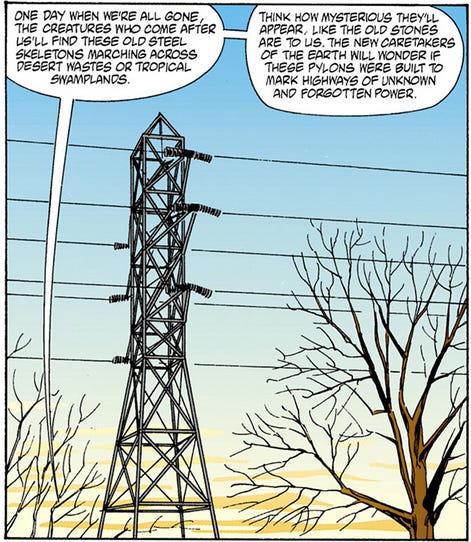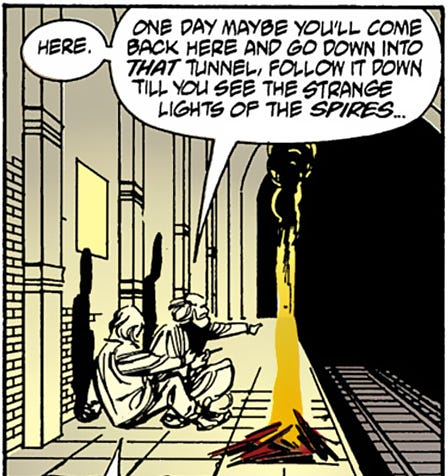The following is provided for entertainment purposes only, none of these activities are recommended, please act within the boundaries of the law and do not do anything which might endanger your personal safety.
A Guide to Re-Enchanting the City
This is a guide to seeing the city with new eyes. This is a mindful approach to urban life that aims to wake you up rather than to confer a legible marker of accomplishment. Instead of the linear, goal-oriented interactions of work, consumption and travel, the idea is to create an open-ended, exploratory and opportunistic relationship to the city. To do this I recommend certain exercises. These are far from exhaustive! This post is a pulling at a thread, and I hope my readers can provide their own insights, recommendations and experiences in the comments below.
This guide is not risk-free. Some of these practices are illegal and dangerous. Furthermore, they may exacerbate certain ambient risks. Homelessness, for example, may put you at greater risk of sexual predation, particularly if you are a woman. However, I hope there are activities in here that can still be practiced by even a very risk-adverse person.
Some of these activities are illegal (see disclaimer above). They are presented, for the most part, without any kind of moralizing. I believe that they can be practiced in a way that is “victimless” or at the very least does not harm anyone whom I care about. A useful step in the re-enchantment of the city is becoming somewhat feral. To do this, you must develop your own approach to morality and legal risk.
Many of the recommended activities in this document are coincide heavily with a countercultural anarchist lifestyle. This is not a coincidence. This was my lifestyle for a major, formative part of my youth. I find that the experience of low-level illegalist anarchism and the aesthetics of crust and cyberpunk are useful approaches to transforming our vision of the city. My goal here is to present this approach in a way that is stripped of ideological pretensions. What I sought (and sometimes found) during this time was not the successful implementation of a political program, but a re-enchantment with life. The politics were simply a “MacGuffin” for a more intense mode of existence.
Image from The Invisibles by Grant Morrison (image cropped
Homelessness
The ideal state to be in to undertake a re-enchantment of the city is one of homelessness – not the homelessness of the broken, but rather the lazy aristocratic homelessness of a Greek philosopher.
This creates a situation where you spend a great deal of time in the city with few demands on that time. That time is not spent insulated in a private apartment, house, or car but rather in public with little to mediate between you and the urban environment. Use of a distracting digital device such as a smartphone, laptop or gaming device will detract from your urban experience and should be avoided.
Ideally, you should not be able to escape boredom by spending money, and you will have to be resourceful in finding the things you need: shelter, security and food. You should also be straight-edge or near straight-edge; if you must spend additional time procuring drugs and alcohol this will detract from the project of re-enchantment (although states of intoxication, if used carefully, can also be useful).
If you spend any time fixed in one spot without much to do, you will observe rhythms that would otherwise escape you. You will observe people coming and going. You will observe the patterns of shop-keeps, commuters, and wildlife. You will also have an array of interactions with people from all walks of life. You may encounter people who want to have sex with you or who wish to rescue you, as well as lonely people who want to talk to someone.
Panhandling is one activity that gives you plenty of opportunity to observe your environment and talk to strangers. For those who have musical (or some other performative talent), busking is an alternative. But the goal should be to spend as much time in public at street-level as possible while being open to random interactions.
If you are homeless, your existence is de facto mildly illegal: you will be chased out of public and semi-public areas, and you will have to search for places to sleep that are sheltered against the elements, concealed from human predators, and where authority figures will not hassle or disturb you.
Arguing with authority figures (particularly police) is a waste of time and potentially very dangerous. Be polite, be well spoken, and comply. Do not volunteer information beyond the minimum necessary. Sometimes you can negotiate to do what you were doing but in a less obtrusive manner, particularly if you convey an impression of someone who is sober, self-possessed and unlikely to create problems.
If you are unable to commit to this experiment for an extended period (perhaps several months, ideally in the summer), here are some exercises you can try:
Volunteer regularly at a soup kitchen, shelter, or drop in center.
Spend a weekend living rough. Sleep outside, make plans for inclement weather, and spend no money.
Attend a soup kitchen or drop in center as if you were a normal client; be discrete, you do not have to lie, but the goal should be to get a feel for the place without drawing attention to yourself. If you feel guilty about using resources marked for the less fortunate, offset this with a donation.
Spend a day sitting in a central, public location such as a park or square and observing.
Illegalism
Regularly being in a state of illegality, even a very low level one, changes your awareness of your environment in a fundamental way. Walking into a store to steal something is a very different experience from walking in to shop. You will see mechanisms of surveillance that were invisible before and develop sensitivities you did not have. You will learn tricks for blending in and evading surveillance. You will learn to see yourself as others see you. To cultivate this awareness, you must have skin in the game; there should be a real risk, but it need not be a catastrophic or lifechanging level of risk. A risk of a fine or citation is sufficient.
Fare evasion, shoplifting, graffiti, squatting, trespassing and direct action (ie, motivated vandalism) are forms of (mild) illegalism which can teach you to be alert and evasive.
For those who wish to go further there are harder and more dangerous forms of illegalism. I have not practiced these, so I am not going to comment on them here. They are fraught with moral hazard, as well as risks to life, limb, and liberty. You will have to make the decision as to whether they are right for you or not, but I have no doubt that they can substantially change your relationship with your environment and the forces that govern it.
Exercise:
A simple way to become alert and aware to authority figures and surveillance is to practice fare evasion on public transit – don’t pay, jump the turnstile, enter through the backdoor, etc.
Squatting
Squatting means living somewhere without title or permission. It can range from very sophisticated operations indistinguishable from living in a rented house or flat, to something that is little more than urban camping. It may be very furtive, with access by night only, or it may be very open. In some cases, neighbours may not even know that the residents are squatters.
Squatting is a long term and challenging project, but a fun and interesting one. The range of tips, tricks and considerations is beyond the scope of this article. Squatting guides must always be taken with a grain of salt as they reflect the experience of those who wrote them as much as any objective reality. A squatting guide written in Barcelona in 2006 or London in 1986 may not be very helpful to you in your city today.
The most important skill to develop if you wish to pursue this path is to figure out what will work. If you are squatting a building you may ask, is this livable, and is there a motivation to remove me? If a building is clean, has intact windows, power, and is in a prime location (such as near a city’s core) it may mean that someone has an interest in this building. Squatting buildings will be harder in cities with tight and booming real estate markets versus those cities in an economic slump. Finding buildings that are at the intersection of livable and genuinely abandoned is tricky.
Keep in mind also that you may have concerns beyond the police; owners of buildings may resort to violence to evict you, and local criminals and hoodlums may not like you drawing heat.
The other kind of squatting is more like urban camping: you may build a permanent or semi-permanent structure on an empty lot somewhere.
Graffiti
I was never a graffiti writer of any accomplishment (limiting myself to crudely scrawled political slogans) but I was lucky enough to have friends who were and to accompany them on their nocturnal wanderings. If you have any talent in this area, I recommend it.
Most artists I know take pride in being able to put their name up in places that are hard to reach, highly visible, or pose substantial risk of getting caught. You will learn to be constantly looking for rooftop access, construction sites, and other ways of moving through urban space that are not defined by patterns of work, consumption or transit. Your environment is transformed into a medium of self-expression.
Image from The Invisibles by Grant Morrison
Urban Exploration
Urban exploration aims to access spaces which are interesting, evocative, and usually slightly forbidden.
You must resist the temptation to think that if you are not finding the kind of cool places that feature in blogs and professional photobooks, you are not doing it right. You will, if you persist, find such places, but first you must make a habit of noticing them.
You can also do a milder form of daytime urban exploration, which entails walking around and seeing which publicly accessible (but overlooked) areas you can enter. For example, seeing which views you can get from various office towers and parkades in the core of any city.
Exercises:
Go on an urban hike. Ideally, you should go on several, and not all at the same time of day. If you are going during the day, make note of sites that are worth returning to at night when no one is around. But the best time for open-ended urban wandering with light trespassing is at night. You must maintain at all times an attitude of curiosity and a willingness to go off the beaten track, to follow strange paths where they pop up. If an area looks interesting to you for whatever reason, check it out.
You can take straight line hikes from one end of a city to another along streets, but where possible, I recommend following other natural and man-made passageways as well. Rail lines, above ground pipes and water mains, rivers, creeks, ravines and shorelines are all obvious candidates. It is often preferable to have no particular destination, make time for open-ended wandering.
"alert" by hikinghillman is licensed under CC BY-NC 2.0
Nature Walks
This is exactly like a nature walk that you might undertake in the forest, but in a city. Walk around, identify plants, animals and mushrooms and visit sites of particular natural interest or beauty. Importantly, do not limit your nature walk to parks and forested areas, but maintain this awareness throughout the city. The range of wildlife you can observe is quite wide. Some animals I have seen in the city include lynx, bald eagles, herons, seals, coyotes, foxes, beavers and deer.
You must break yourself of the habit of seeing the “natural world” as something that is remote and distinct from your urban life, confined only to pristine wildernesses that you view through screens and the printed page.
Image from The Invisibles by Grant Morrison
Rail Lines
Rail lines and rail yards hold a special power and fascination for me that is difficult to convey in words. They connect the heart of cities to other cities across vast swathes of land and remote wildernesses. They are important areas for subcultures such as hobos and graffiti artists. They offer chances for solitude, reflection and wildlife encounters, and evoke sublime aesthetics of industrial dystopia and decay.
Exercises:
Walk along the rail lines through your city for as long as you can, or for a significant length. Be warned; this is usually illegal and can result in arrest/citation. Be mindful of oncoming trains. Do not do this while you are intoxicated or incapacitated.
Ride freight trains for extended periods of time between cities. The precise mechanics of how to do this are beyond the scope of this article; if you can, find someone who already does this and get them to show you, but people can and do ride without any specialized knowledge or initiation (I didn’t have any my first time). If you do this, use common sense, assume that any train can start moving at any time and do not put yourself in a position to be injured or killed if the train lurches unexpectedly.
The Peripheries of Cities
The peripheries of cities are often less dense than their cores in the things that humans read as meaningful – there may be miles of warehouses that are left empty at night and the bland sameness of big box stores and parking lots.
To overlook these areas would be a mistake, however. They are the liminal spaces where the city meets the country.
The best way I have found to experience these places is by travelling between cities – often by hitchhiking or freight hopping.
The Other City – the Sacred, the Profane and the Sinister
This guide aims for re-enchantment. This implies making the city into a place that is felt as both mysterious and meaningful - a place where anything can happen (and frequently does). The next step might be a spiritual practice. After a while you may start to get a feel for an invisible spiritual landscape in your city. You may find places in your wanderings that have a certain energy. There may be places that, for no reason you can identify, radiate malevolence, and places that are infused with holiness. You may discover abandoned places of worship and burial grounds. There may be medicinal plants and intoxicants that grow wild in your city.
The goal of such a practice would be to develop sensitivity to these energies and respond appropriately – through activities like pilgrimage, shunning (in the case of malevolent energies), shrine building, leavings of offerings, vigils and vision quests, etc. This is a path I have not yet gone down, and I cannot say with any certainty that I will.
Other tips and recommendations
You should experience the city in various mental states. You may wish to experiment with (mild) forms of intoxication, as well as stone-cold sobriety and sleep deprivation.
You should experience the city at different times of day; like the “witching hour” of 2-4 in the morning, as well as at very early morning when everything is getting started.
When possible and safe to do so, walk down alleyways instead of streets for a new perspective.
Go into churches if they are open during the day.
Other possibilities that I have not tried: parkour, skateboarding, sex work, drug dealing, bike couriering, delivery jobs in general, research into local history, haunted tours, exploration by boat.
Recommended Reading
Neverwhere by Neil Gaiman
The Invisibles by Grant Morrison
From Hell by Alan Moore
Seeing Like A State by James C. Scott
The Crew Change Guide by Train Doc
Chöd, inner trolls, bridges and inner stagnation… by Repa Dorje Odzer
Recommended playlist – songs with a strong urban vibe or theme, there are many more, particularly in the genres of rap and hip hop, which I am largely unfamiliar with!
1. “Inherit the Wasteland” by Nausea
2. “American Waste” by Black Flag
3. “Bullet the Blue Sky” original by U2, Sepultura cover recommended
4. “Keep on Rocking in the Free World” by Neil Young
5. “Interzone” by Joy Division
6. “Stones from the Sky” by Neurosis
Recommended viewing
Koyaanisqatsi directed by Godfrey Reggio
Style Wars directed by Tony Silver
The Battle of Algiers directed by Gillo Pontecorvo
Some of my favorite cities: Vancouver (especially East Van!), Montreal, New Orleans, Berlin, Barcelona, Thessaloniki (Salonica).
Cities I would like to spend more time in: Amsterdam, Beograde, San Francisco, DF (Mexico City).
Image from The Invisibles by Grant Morrison (cropped)






Useful advice for law breakers. Never break more than one law at a time.